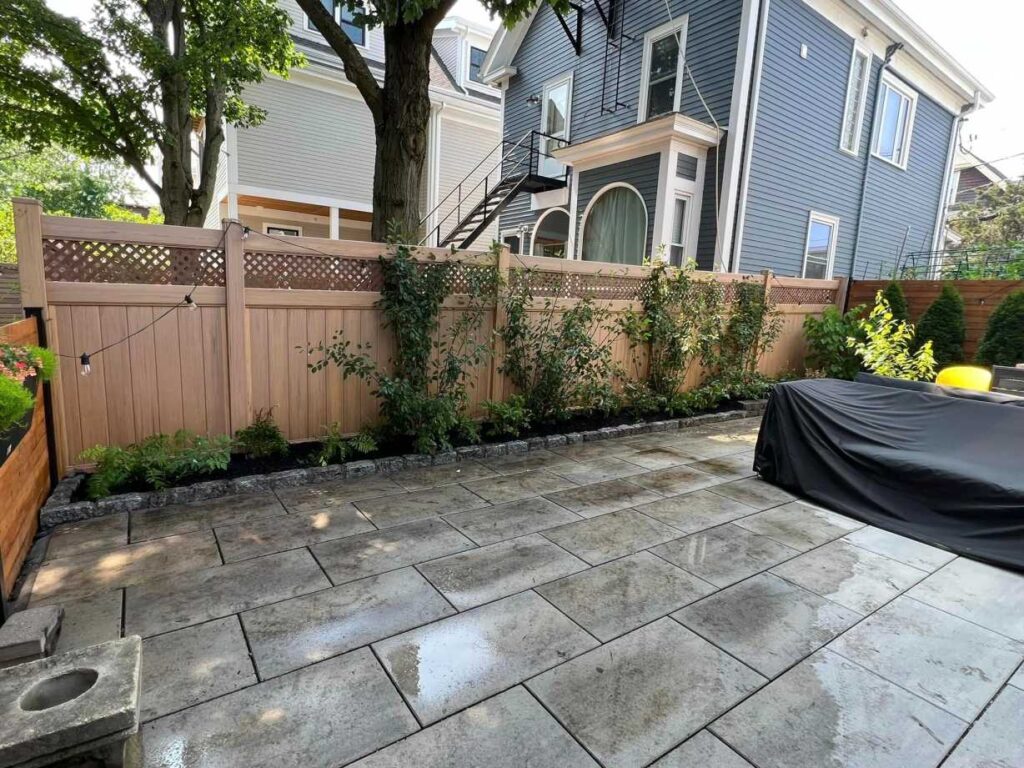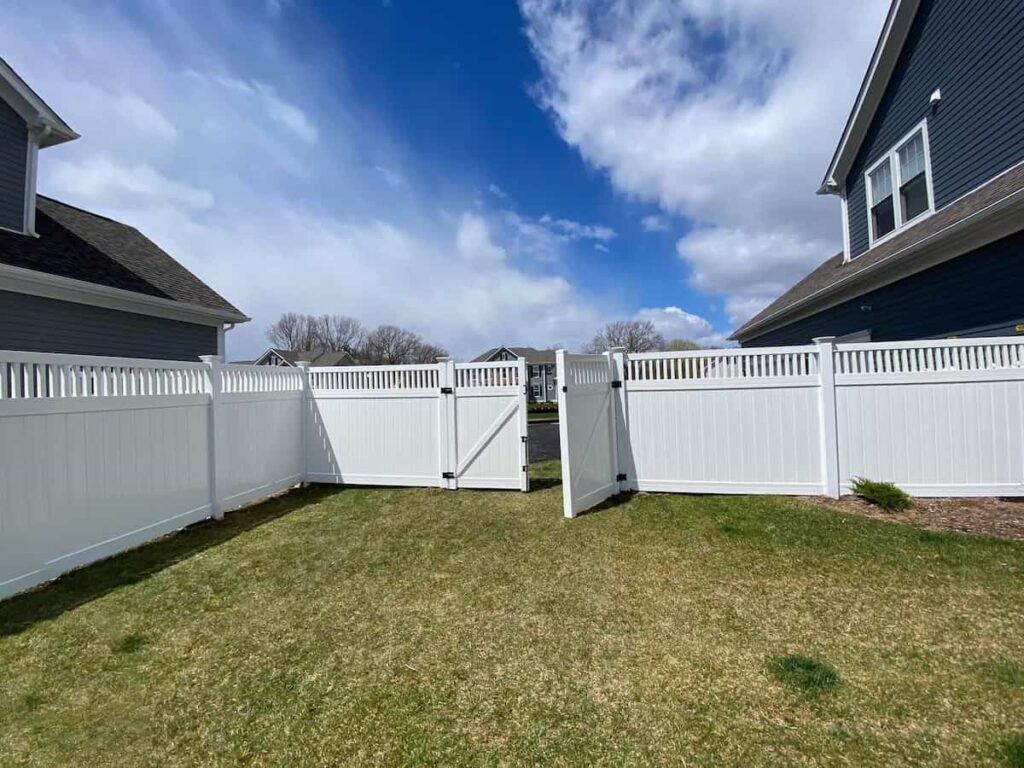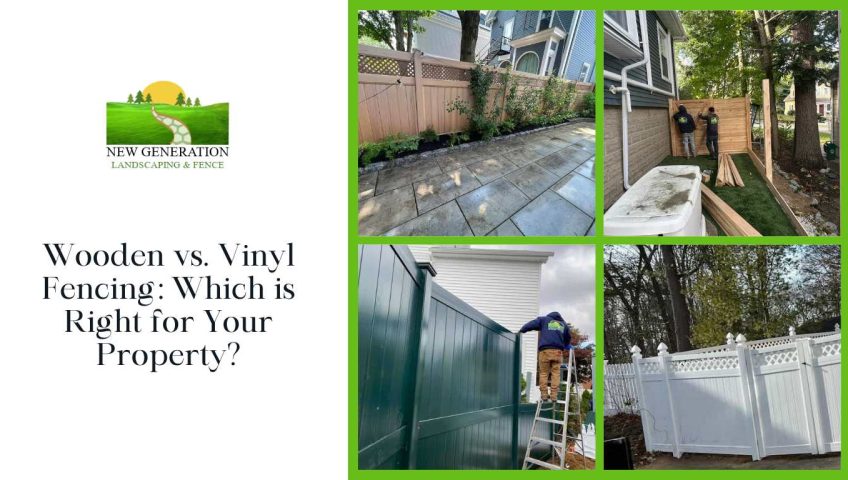When it comes to enhancing your property’s security, privacy, and curb appeal, choosing the right fencing material is crucial. At New Generation Landscaping & Fence, we often find our clients torn between two popular options: wooden and vinyl fencing. Both materials have their unique characteristics, advantages, and potential drawbacks. In this comprehensive guide, we’ll delve deep into the world of wooden and vinyl fencing to help you make an informed decision that best suits your property and lifestyle.
Wooden Fencing: The Timeless Classic
Wooden fences have been a staple in American landscapes for centuries, and for good reason. They offer a natural, warm aesthetic that complements various architectural styles and landscaping designs.
Pros of Wooden Fencing:
- Natural Aesthetic: Wood fences provide a timeless, rustic appeal that can enhance the beauty of any property. The natural grain patterns and textures of wood create a unique, organic look that many homeowners find irresistible.
- Customization Options: One of the biggest advantages of wooden fencing is its versatility in terms of customization. You can easily paint or stain wood to match your home’s exterior or change its look over time. From picket fences to privacy panels, wood can be crafted into various styles and designs.
- Cost-Effective: Generally, wooden fences are less expensive upfront compared to vinyl, making them an attractive option for budget-conscious homeowners.
- Eco-Friendly: Wood is a renewable resource and biodegradable, making it an environmentally friendly choice. When sourced responsibly, wooden fences have a lower environmental impact compared to synthetic materials.
- Easy Repairs: If a section of a wooden fence gets damaged, it’s relatively easy and inexpensive to replace individual boards or panels without having to redo the entire fence.

Cons of Wooden Fencing:
- Maintenance Requirements: Wood requires regular upkeep to maintain its appearance and structural integrity. This includes periodic painting, staining, or sealing to protect against moisture, UV rays, and pests.
- Vulnerability to Elements: Without proper care, wooden fences can be susceptible to rot, warping, and insect infestations, especially in areas with high humidity or frequent rainfall.
- Shorter Lifespan: Typically, wooden fences last about 10-20 years, depending on the type of wood, quality of installation, and maintenance routine.
- Prone to Weathering: Over time, wood can develop a weathered appearance, which some homeowners find charming, while others may see it as a drawback.
Best Scenarios for Wooden Fencing:
- Traditional or rustic-style homes where natural materials enhance the overall aesthetic
- Properties where the fence design needs to match existing wooden structures
- Areas with moderate climates that aren’t too hard on wooden structures
- Homeowners who enjoy DIY projects and don’t mind regular maintenance
Vinyl Fencing: The Modern Alternative
Vinyl fencing has gained popularity in recent years as a low-maintenance alternative to traditional wooden fences. Made from PVC (polyvinyl chloride), vinyl fences offer durability and consistency in appearance.
Pros of Vinyl Fencing:
- Low Maintenance: One of the biggest selling points of vinyl fencing is its minimal maintenance requirements. It doesn’t need painting, staining, or sealing. Simple cleaning with soap and water is usually sufficient to keep it looking new.
- Durability: Vinyl is highly resistant to rot, insects, and harsh weather conditions. It doesn’t splinter, warp, or decay like wood can.
- Longevity: With proper care, vinyl fences can last 20-30 years or even longer, making them a long-term investment for your property.
- Consistent Appearance: Vinyl fencing retains its color and doesn’t fade significantly over time, ensuring a uniform look throughout its lifespan.
- Variety of Styles: Modern vinyl fencing comes in a wide range of styles and colors, including options that mimic the look of wood or other materials.

Cons of Vinyl Fencing:
- Higher Initial Cost: The upfront cost of vinyl fencing is typically higher than wood, which can be a deterrent for some homeowners.
- Limited Repair Options: If a section of vinyl fencing is damaged, it often requires replacing entire panels rather than individual components.
- Less Natural Look: Despite improvements in manufacturing, some homeowners still find vinyl less aesthetically pleasing than natural wood.
- Environmental Concerns: Vinyl is not biodegradable and its production process can have environmental impacts.
- Potential for Fading: While more resistant to fading than wood, some lower-quality vinyl fences may discolor over time, especially in areas with intense sunlight.
Best Scenarios for Vinyl Fencing:
- Homes in coastal or high-humidity areas where wood might deteriorate quickly
- Properties where owners want a long-lasting fence with minimal upkeep
- Modern or contemporary-style homes that complement the sleek look of vinyl
- Areas prone to termites or other wood-destroying insects
Factors to Consider When Choosing Between Wood and Vinyl
- Budget Considerations:
- Short-term vs. long-term costs
- Initial installation expenses
- Ongoing maintenance and repair costs
- Climate and Environmental Factors:
- Local weather patterns (humidity, rainfall, temperature extremes)
- Sun exposure and potential for UV damage
- Presence of pests like termites or carpenter ants
- Aesthetic Preferences:
- Desired look and feel (natural vs. modern)
- Compatibility with home’s architectural style
- Neighborhood trends and HOA regulations
- Maintenance Willingness:
- Time available for fence upkeep
- DIY skills and interest in home improvement projects
- Budget for professional maintenance services
- Longevity Needs:
- How long you plan to stay in your current home
- Desire for a one-time investment vs. potential for change
- Property Value Considerations:
- Impact on resale value
- Curb appeal and first impressions for potential buyers
Maintenance Tips
For Wooden Fences:
- Apply a water-repellent sealant every 1-2 years
- Inspect regularly for signs of rot, insect damage, or loose boards
- Clean with a mild detergent and soft brush annually
- Address any issues promptly to prevent further damage
For Vinyl Fences:
- Wash with soap and water or a mild vinegar solution annually
- Check for any cracks or damage after severe weather events
- Avoid using abrasive cleaners or pressure washers
- Trim vegetation away from the fence to prevent staining
Making Your Decision
Choosing between wooden and vinyl fencing ultimately depends on your specific needs, preferences, and circumstances. Here are some final thoughts to consider:
- If you value natural beauty and are willing to invest time in maintenance, wooden fencing might be your best bet. It offers a classic look that can be customized to your liking and can be more budget-friendly upfront.
- If you prioritize longevity and low maintenance, vinyl could be the ideal choice for your property. While it may cost more initially, its durability and minimal upkeep requirements can make it more cost-effective in the long run.
At New Generation Landscaping & Fence, we understand that every property and homeowner is unique. Our experts are here to help you navigate this important decision. We can provide personalized advice based on your property’s characteristics, your aesthetic preferences, and your long-term goals.
Whether you choose the timeless appeal of wood or the modern convenience of vinyl, we’re committed to delivering high-quality fencing solutions that enhance the beauty, security, and value of your property. Contact us today to discuss your fencing options and take the first step towards transforming your outdoor space.
